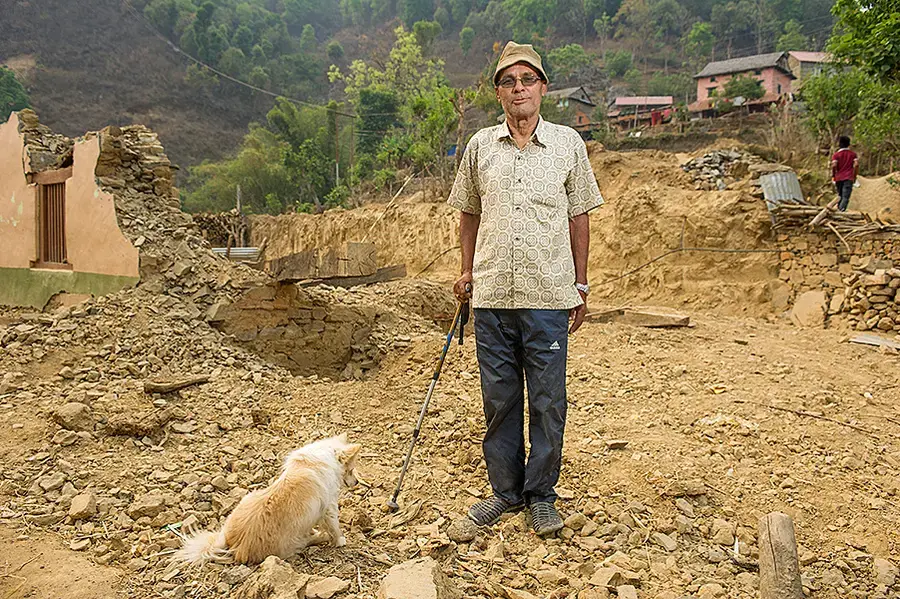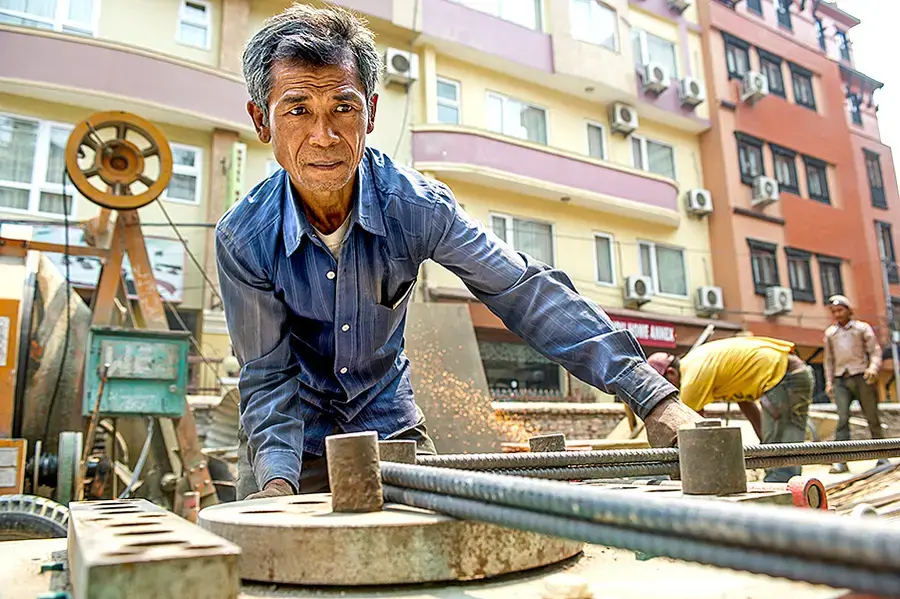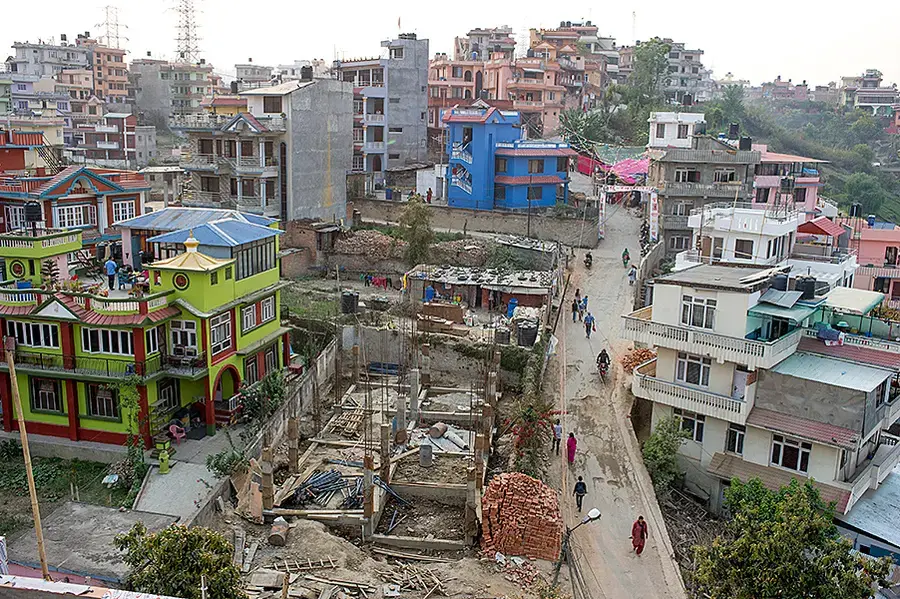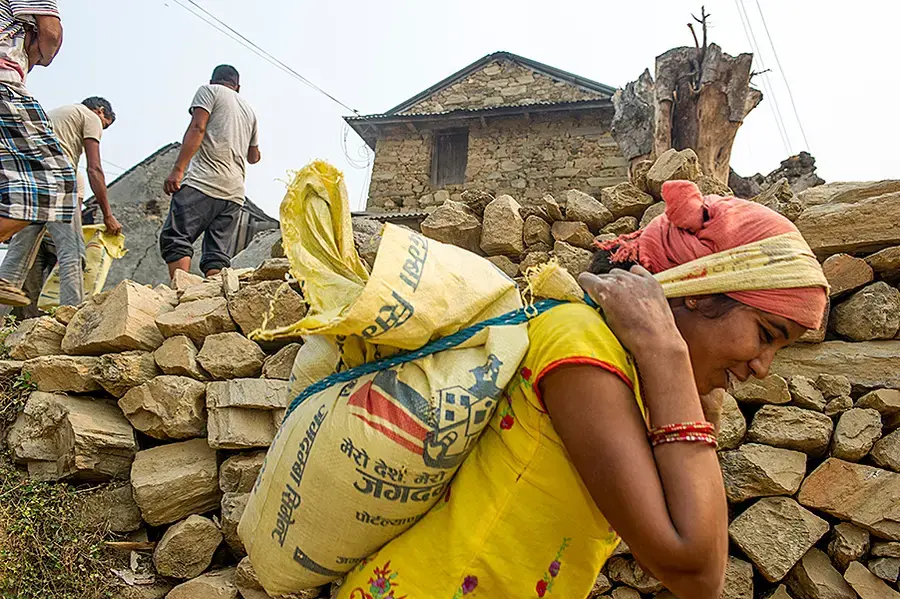AMPPIPAL, NEPAL — Hom Bahadur Basnet walks with the help of a cane through the rubble of his former home, a two-story house built of stone and plaster. The front door frame and bathroom walls are all that survived the earthquakes that pummeled Nepal a year ago.
Twenty feet away stands his new home: a cluttered shack pieced together from corrugated metal sheeting, bamboo poles, and salvaged wood. Mr. Basnet built it 10 days after the initial 7.8-magnitude quake that struck on April 25, 2015. He has lived in it with his wife, daughter-in-law, and grandson ever since.
The April 25 tremor and its powerful aftershocks – Nepal's worst natural disaster in eight decades – killed nearly 9,000 people and left two million homeless. A year later, the government has yet to rebuild a single permanent house or school – a fact that has frustrated citizens of this Himalayan nation.
Those who survived the quakes are still struggling to restore their lives. Millions are waiting for government grants to rebuild their homes. Most, like Basnet and his family, live in makeshift shelters; the less fortunate make do with tents.
"We can't survive another winter like this," says Basnet, whose left side was partially paralyzed by a stroke he suffered last summer. "This house isn't made for the cold. The roof can't even withstand a strong wind."
A trickle of rebuilding funds
Basnet says he hopes to build a new house before December. But as a retired soldier turned subsistence farmer, he can't afford to pay for it on his own. Instead, he's waiting for government assistance. It seems he may have to go on waiting for a long time.
The National Reconstruction Authority (NRA), the agency formed to rebuild the country, has promised 200,000 rupees, about $1,900, for each home that needs to be rebuilt in addition to subsidized loans to complete construction.
Nepal has signed agreements for almost half of the $4.1 billion pledged by foreign donors last June. Yet only now is the country's government beginning to hand out grants for rebuilding.
Though the NRA has promised to speed up cash distribution this month, observers warn that more delays are all but inevitable given the overwhelming demand. From Kathmandu to Amppipal, a remote mountain village located about 15 miles southwest of the epicenter of the first earthquake, patience is wearing thin as the annual monsoon season approaches.
"We always thought the government's response would be slow," says Nayan Pokhrel, a researcher at the Kathmandu-based Democracy Resource Center who has grown accustomed to Nepal's convoluted bureaucracy. "But we didn't think it would be as sluggish and as hopeless as this."
Mr. Pokhrel blames the delay partly on a series of political challenges. Demonstrators protesting Nepal's new constitution blocked roads and disrupted imports of fuel and other essentials from neighboring India for five months, until early February.
But Pokhrel says the government has also displayed an alarming level of incompetence in its handling of reconstruction. The NRA didn't launch until December, hamstrung by partisan political wrangling over its makeup. Pokhrel says its survey of damaged houses was haphazard and led to confusion over who qualifies for grants and what quake victims need to enroll.
'A time-consuming thing'
The NRA faces a daunting task. Government data suggest the earthquakes destroyed about 600,000 homes and badly damaged 280,000 more. About two million people were left homeless. Reconstruction is expected to cost $6.6 billion, of which half will be needed for housing and resettlement.
NRA spokesman Ram Prasad Thapaliya says the first installment of government grants, about $470 each, has been distributed to 500 people in Singati, a town near the epicenter of a massive aftershock that struck 50 miles east of Kathmandu on May 12.
By July, the agency plans to disburse the first installment to households in 11 of the most affected districts, home to about three million people. But confusion surrounding the enrollment process threatens to hamper its efforts.
"We are supposing within three years, most of the house owners could build their homes" with the help of government grants, says Mr. Thapaliya. He says the authorities will need an additional two years to complete the reconstruction of roads, bridges, and other damaged infrastructure.
Distributing the grants in three installments is designed to give inspectors enough time to ensure the rebuilt homes meet new earthquake-resilience standards. Yet officials acknowledge that $1,900 is far from enough to cover the total costs of an average new home, which homeowners and analysts say can exceed $7,500.
Thapaliya admits the process has been frustrating for quake victims, but he argues that reconstruction after natural disasters is often slow in other parts of the world too. "It's a time-consuming thing," he says, adding that the political squabbling over the new constitution added to the delays.
Hurting the economy
Still, the longer those delays last, the more damage they will do to Nepal's already fragile economy. The Asian Development Bank (ADB) estimates economic growth will slide to 1.5 percent this fiscal year, down from 3 percent last year. The blockade and subsequent fuel shortages also contributed to the grim forecast.
Kenichi Yokoyama, the ADB's country director for Nepal, says growth could rise to 4.8 percent in 2017, but only if reconstruction begins soon.
In Amppipal, Basnet and his family have little choice but to wait for the long-promised grants to trickle down. In the meantime, they have built a shed for their two water buffalo and small herd of goats, with space on an upper floor to store rice, lentils, and vegetables. For now, the family plans to stay put in their small shack.
"That's how our government is," says Basnet. "They say they'll give us money, but they haven't given any yet. We may have to live here for some time."


















